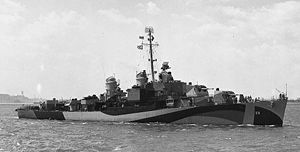- USS Henry A. Wiley (DM-29)
-

Career 
Builder: Bethlehem Shipbuilding Corporation, Staten Island, New York Launched: 21 April 1944 Commissioned: 31 August 1944 Decommissioned: 29 January 1947 Struck: 15 October 1970 Fate: sold for scrapping, 30 May 1972 General characteristics Class and type: Robert H. Smith-class destroyer Displacement: 2,200 tons Length: 376 ft 5 in (114.73 m) Beam: 41 ft (12 m) Draft: 15 ft 8 in (4.78 m) Speed: 34 kts Complement: 336 officers and enlisted Armament: 3 5", 8 20mm USS Henry A. Wiley (DD-749/DM-29/MMD-29) was a Robert H. Smith-class destroyer minelayer in the United States Navy. She was named for Admiral Henry A. Wiley.
Henry A. Wiley was launched 21 April 1944 as DD-749 by Bethlehem Steel Company, Staten Island, New York; sponsored by Mrs. Elizabeth W. Robb, daughter of Admiral Henry A. Wiley; reclassified DM-29 20 July 1944 and commissioned 31 August 1944, Commander Robert Emmett Gadrow in command.
After shakedown in the Caribbean Sea, the new minelayer rendezvoused with the battleships USS Texas (BB-35), USS Arkansas (BB-33), and USS Missouri (BB-63) and sailed 8 November for the Pacific to earn her nickname "Hammering Hank." Henry A. Wiley reached Pearl Harbor 9 December to prepare for the impending Iwo Jima campaign. As escort to the battleship USS New York (BB-34), she rendezvoused with other ships of the Gunfire and Covering Force off the rocky Japanese island on 16 February 1945, 3 days before the initial landings. She remained there until 9 March, to provide fire support and screen ships often operating a mere 400 yards from Mount Suribachi. The minelayer poured some 3,600 rounds into the Japanese fortress.
A second and even more arduous campaign followed for Henry A. Wiley—Okinawa, the largest amphibious operation of the Pacific war. Reaching her position 23 March, D-day minus eight, she began to screen minesweepers as they cleared channels for transports and support ships. Japanese resistance was fierce and air attacks were almost unceasing. On 28 March, Henry A. Wiley downed two kamikaze planes, and the next morning in 15 hectic minutes saw a bomb explode 50 yards astern, downed two more kamikazes, and rescued a downed fighter pilot. While screening transports on 1 April, D-day at Okinawa, Henry A. Wiley destroyed her fifth kamikaze.
The battle-tried ship then shifted to radar picket duty and spent a total of 34 days on this important task, alerting other ships of enemy air attacks. During this period, Henry A. Wiley took 64 Japanese aircraft under fire, destroying several of them. The morning of 4 May proved especially eventful. She began by downing a Betty at 0307. When her sister ship, USS Luce (DD-522), was reported sinking, Henry A. Wiley proceeded to her aid, but came under heavy air attack. In less than a quarter hour of heavy fighting, the valiant ship splashed three kamikazes and two Baka bombers, one of which was closing from the starboard quarter when it was hit by Henry A. Wiley's accurate fire. It hit the water, bounced over the fantail, and exploded just off the port quarter. Having expended nearly 5,000 rounds of 5-inch and AA ammunition, the minelayer then proceeded to rescue survivors from Luce. For her intrepid actions off Okinawa, which resulted in the destruction of 15 Japanese planes, Henry A. Wiley received the Presidential Unit Citation, and her skipper the Navy Cross and Legion of Merit.
From Okinawa, Henry A. Wiley sailed for the East China Sea, entering 12 June to screen minesweepers attempting to clear that vast body of water. She remained on this duty, with brief respites at Buckner Bay, until peace came. Even this duty was ushered in to the sound of "Hammering Hank's" guns, as on the night of 14 August, 24 hours before final orders to cease offensive operations against the Japanese were received, she went to General Quarters 6 times at the approach of aircraft, finally opening fire on the 6th run as an attack run commenced. Henry A. Wiley remained in the Pacific to screen and guide minesweepers through the end of 1945. She streamed her homeward bound pennant 17 January 1946 and on 7 February reached San Francisco, California via Eniwetok and Pearl Harbor. Henry A. Wiley decommissioned at San Francisco 29 January 1947 and went into reserve at San Diego, California. Henry A. Wiley was struck from the Naval Vessel Register on 15 October 1970 and sold for scrapping on 30 May 1972.
In addition to the Presidential Unit Commendation, Henry A. Wiley received four battle stars for her participation in World War II.
As of 2009, no other ship has been named Henry A. Wiley.
References
This article includes text from the public domain Dictionary of American Naval Fighting Ships.
External links
- Photo gallery at Navsource.org
Robert H. Smith · Thomas E. Fraser · Shannon · Harry F. Bauer · Adams · Tolman · Henry A. Wiley · Shea · J. William Ditter · Lindsey · Gwin · Aaron Ward
List of destroyers of the United States Navy · List of destroyer classes of the United States NavyCategories:- Robert H. Smith class destroyers
- Ships built in New York
- 1944 ships
Wikimedia Foundation. 2010.
